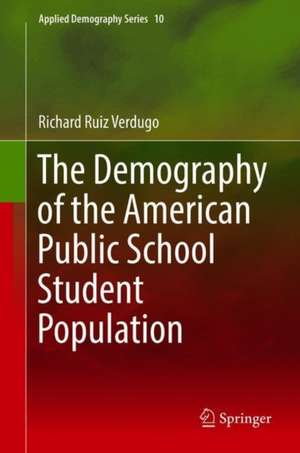American Education and the Demography of the US Student Population, 1880 – 2014: Applied Demography Series, cartea 10
Autor Richard R. Verdugoen Limba Engleză Hardback – 15 oct 2018
This monograph examines changes in the American public school population from 1900 to 2010. It shows how different historical periods have affected the composition of the student body and have posed important challenges to those involved in shaping educational policy.
The author first develops an analytical framework that merges education and applied demography concepts. The education concepts include attendance, promotion, retention, high school graduation, and college enrollment. While, the applied demography concepts take into account size, distribution, and composition. He then applies this framework to the four most recent American historical periods: the Progressive Era, the Great Depression, the Post WWII Era, and the Post 1983 Era.
Readers will come to understand the changing socio-demographic profile of American schools due to such factors as immigration from Europe, child labor laws, internal migration, greater fertility and the rise of t
he Baby Boom generation, the changing status of women and minorities, the urban crises, rising social inequality, the 2008 recession, and globalization. Featuring both historical and current data, this volume clearly shows how demographic change affects the teaching and learning environment, education policy, funding, and school segregation. Overall, it offers insightful analysis that may help shape the future of American education.
| Toate formatele și edițiile | Preț | Express |
|---|---|---|
| Paperback (1) | 578.61 lei 38-45 zile | |
| Springer International Publishing – 14 dec 2018 | 578.61 lei 38-45 zile | |
| Hardback (1) | 660.37 lei 6-8 săpt. | |
| Springer International Publishing – 15 oct 2018 | 660.37 lei 6-8 săpt. |
Preț: 660.37 lei
Preț vechi: 776.90 lei
-15% Nou
Puncte Express: 991
Preț estimativ în valută:
126.36€ • 132.41$ • 104.46£
126.36€ • 132.41$ • 104.46£
Carte tipărită la comandă
Livrare economică 11-25 aprilie
Preluare comenzi: 021 569.72.76
Specificații
ISBN-13: 9783319894225
ISBN-10: 3319894226
Pagini: 412
Ilustrații: LXV, 505 p. 106 illus.
Dimensiuni: 155 x 235 x 36 mm
Greutate: 0.97 kg
Ediția:1st ed. 2018
Editura: Springer International Publishing
Colecția Springer
Seria Applied Demography Series
Locul publicării:Cham, Switzerland
ISBN-10: 3319894226
Pagini: 412
Ilustrații: LXV, 505 p. 106 illus.
Dimensiuni: 155 x 235 x 36 mm
Greutate: 0.97 kg
Ediția:1st ed. 2018
Editura: Springer International Publishing
Colecția Springer
Seria Applied Demography Series
Locul publicării:Cham, Switzerland
Cuprins
Part One: Theoretical Background.- Chapter 1: A brief history of the American Educational System.- Chapter 2: The changing demography of the American population: 1900 – 2010.- Chapter 3: Demography and education: A research framework.- Part Two: The Demography of the American Student.- Population: 1900 to 2010.- Chapter 4: The Progressive Era.- Chapter 5: The Great Depression.- Chapter 6: The Post WWII Era.- Chapter 7: The Post 1983 Era.- Chapter 8: Conclusion.
Notă biografică
Richard R. Verdugo is a Sociologist, having earned a Doctorate in the field from the University of Southern California. He has retired from the labor force, and currently resides in the Ukraine, but shuttles between the Ukraine and other European nations. Richard’s research interests are eclectic as he has published regularly in four research areas: sociology, economics, education, and demography. His most recent publications include two books (Education Reform in Europe; and Latin American Immigrants in Spain, with Andreu Domingo and Albert Sabater). He has a forthcoming book on National Identity in Europe (with Andrew Milne), in which he has co-authored three chapters: one a general introduction to the topic, with Andew Milne; one on national identity in Germany, with Dana Martin; and another on national identity in Russia, with Oxana Karnaukhova. His most recent journal articles include two papers in the International Journal of Education Reform, whichhe Guest Edited (Education Reform in China, with Aihua Hu; and a paper on Education Reform and Community). His most recent research focuses on PISA and Social Structure; underutilized labor in Europe; the Demography of the US school population from 1900 to 2010; non-English use in the USA as a measure of Ethnicity from 1910 to 2010; a study of the American Sociology from 1900 to 2000; and research on the labor market experience of the Mexican American Worker from 1940 to 2010.
Textul de pe ultima copertă
This monograph examines changes in the American public school population from 1900 to 2010. It shows how different historical periods have affected the composition of the student body and have posed important challenges to those involved in shaping educational policy.
The author first develops an analytical framework that merges education and applied demography concepts. The education concepts include attendance, promotion, retention, high school graduation, and college enrollment. While, the applied demography concepts take into account size, distribution, and composition. He then applies this framework to the four most recent American historical periods: the Progressive Era, the Great Depression, the Post WWII Era, and the Post 1983 Era.
Readers will come to understand the changing socio-demographic profile of American schools due to such factors as immigration from Europe, child labor laws, internal migration, greater fertility and the rise of t
he Baby Boom generation, the changing status of women and minorities, the urban crises, rising social inequality, the 2008 recession, and globalization. Featuring both historical and current data, this volume clearly shows how demographic change affects the teaching and learning environment, education policy, funding, and school segregation. Overall, it offers insightful analysis that may help shape the future of American education.
Caracteristici
Examines the relationship between demography and American education Includes coverage of the four most recent American historical periods: the Progressive Era, the Great Depression, the Post WWII Era, and the Post 1983 Era Offers a vital portrait of the US educational system over time










